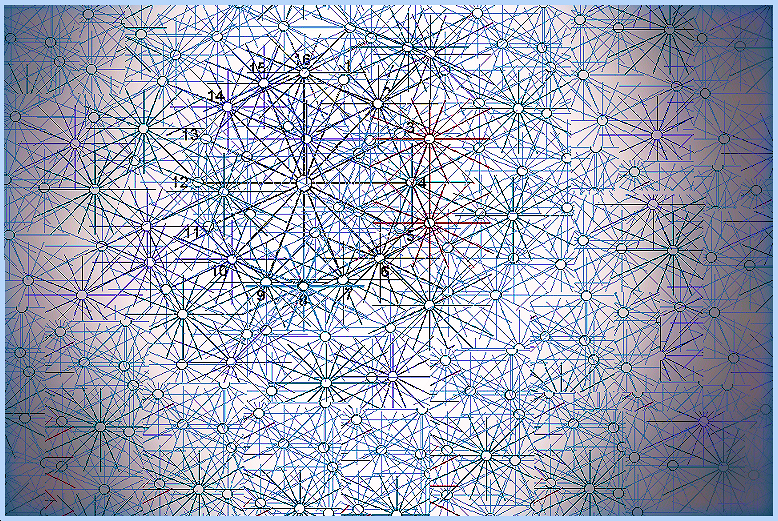Home › Forums › Time Space Knowledge › Unformulated Experience
Tagged: edge of the future, the unformulated, zero point, zeroless
- This topic has 8 replies, 2 voices, and was last updated 08/13/2022 at 2:33 PM by Michael Gray.
-
AuthorPosts
-
-
July 4, 2022 at 2:11 pm #970

Photo: ‘Zeros’ – Pixabay https://pixabay.com/photos/grapes-fruits-food-fresh-healthy-3550733/
Here are a few things I posted a while back in which I quoted Rinpoche, and also from the book ‘Unformulated Experience,’ by Donnel B. Stern. I mentioned in a recent TSK Study Group, as we tried to get our heads around the ‘gap’ between thoughts, that it’s really only a gap/blank, [or openness], depending on the perspective we have adopted. I promised the group I would share some quotes from the books… Not suggesting I have answers or am proclaiming anything in these posts. Think of them as practice notes on my journey of inquiry…
INQUIRING INTO ZERO… LISTENING…
“We might think of zero as a remark by space, a saying that expresses an allowing. Space shows itself in zero. As the symbol of form, the place-holder, zero speaks in all language and in each connection. As the voice of space, it is knowledge communicating with time and space, making the meanings. Knowledge draws the circle that gives zero shape, and zero in turn communicates what knowledge chooses to shape. Zero makes possible the ‘what; of ‘where’, the form that holds meaning, the moving from point to point.”
…..‘Sacred Dimensions of Time and Space,’ Tarthang Tulku, p. 50-2 [Emphasis added]Rinpoche further suggests:
“We should be able to go beyond the zero-point of origination to a knowledge that is zeroless… At the same time, going beyond must stay within ordinary appearance, for only within appearance can we stay true to the possibility of a ‘sourceless source’.
In the going beyond of prior knowledge, we start from the zero point and move toward the limits of our experience. We expand outward and turn inward; we trace the lineage of the past and activate the possibilities of the future. Eventually we return to the starting point. But now the starting point is no longer a point of origination. We realize that there was nowhere to go, and that in a certain sense the journey never took place. The change is subtle, but absolutely fundamental. The quality of time itself is different, and the dimensions of space are not what we thought they were. It no longer makes sense to consider origins or departures from origins in the same way. How can we know that such a journey truly evokes new knowledge?
….‘Dynamics of Time and Space’, by Tarthang Tulku, p.189-90 [Emphasis added]So for instance, when I am in the process of writing, trying to conceptualize or circumscribe what I mean to say, I am aware of an ABSENCE, a kind of place-holder…an ‘intentional space’. There is an acceptance of an arising and the ‘simultaneous recognition of’ meaning, and the absence that is suddenly understood to have preceded it. Writing is one way that allows me to glimpse, or dwell in, this ABSENCE. I might hesitantly describe as the humblest of spaces, this fundamental ‘prior to zero’ meets zero as an edge of the future experience of ‘knowing the knowing’, of being intimate with the center of my universe, my evolving, spiraling constellation, a tasting of the fruit of zero. Right THEIR… where the zeroless feeds the zero-point… is what I’m dwelling in momentarily and beginning, again and again. That being in the middle of the ripple, is the experience I love… free flight… that is ‘the feel’ of my own depth being plumbed…
You could say space meets time in zero, the forms of time whisper space at zero, they FIT. Without a feeling of ‘fit’, how can one develop a sense of conviction? Psychologist Donnel B. Stern PhD., suggests in his book, ‘Unformulated Experience’…
“Because preexisting nonlinguistic representations must be interpreted in language before they can be reflected on, there is no such thing as pristine ‘preexisting content’ that exist in the mind, and against which the ‘accuracy’ of the verbal interpretation can be tested. In a very real sense, the interpretations we make of nonlinguistic unconscious representations ARE those representations, because those interpretations are as close as we can get to thinking about them.
What then accounts for the [person or a patient in psychoanalysis] feeling of fit? The perception of fit follows the patient’s sudden feeling of always having known in some vague way. We seem to know when we have fit our words to a preexisting meaning, or perhaps better, a preexisting ABSENCE.” [We seem to know when the interpretation SPEAKS to US.]
[Regarding curiosity] It is not merely the conscious application of inquisitiveness, the asking of questions. It is the more basic capacity to become aware of questions, of gaps in the material, to sense that there is something there to be curious ABOUT. Curiosity is the sensitivity to the possibility of a question.” [The means to gain self-reflective access to experience.] p.170-6 [Emphasis added]
So when I am writing, and I pause to consider what to say and how to express it… at the heart of it… it’s a zero-point, a welcoming pause, waiting, you might say, for the zeroless to inform zero, so that I may speak it through my voice.
——————————————————
In his book ‘Unformulated Experience’, Donnel B. Stern explains, the title refers not only to all the… “knowable, communicable implications that have never been spelled out, perceptions that have habitually been passed over, but also, the ongoing organizing activities that supply life with continuity. Unformulated experience is, the moment-to-moment state of vagueness and possibility from which the next moment’s articulated experience emerges.” He writes further…
“The structure of unformulated experience is like a figure emerging from a dense fog. There is contour there, but it is fuzzy.” [He goes on to say regarding perception], “Experience depends on the meanings we assign to it. Even when meaning just ‘arrives; in our awareness (that is, when we do not sit and ‘figure it out’), as it most often does, we have played a much larger role in its formulation than we have any idea” p. 44-8
“What is formulated out of unformulated experience is MEANING. Reality does NOT simply confront us. We INTERPRET our way through time. And the unformulated also refers to a kind of ‘selective inattention’; what we filter out in the formulating process by limiting our ‘focal attention’ to – keep something out of awareness. If one’s focal attention is never trained on this ‘something’, one is never aware of it, it remains unformulated.” [p. 59] “The selective inattention screens out experience ‘prior to articulation’, and so avoids cognizing and is excluded from the self-system. It can never be elaborated.”
You could call this a kind of ‘NOT-KNOWING’; it underlies the formulating of experience, and is just as influential as what is allowed INTO interpreted experience. Not-knowing can be a source of anxiety because of the tendency we all have to avoid the unfamiliar. But NOT-KNOWING can also be relied on AS A SOURCE of meaning, and the openness experience that one feels at THE EDGE OF THE FUTURE, where the ever unfolding NOW reveals where the vitality of being, and the richness of knowing found, and activate each instant.
-
July 5, 2022 at 12:11 pm #971

Photo: ‘Spaces within Spaces’ by Myriams-Fotos – Pixabay https://tinyurl.com/y4evrrzw
Here’s another post related to the one above…
SPACE WITHIN SPACE WITHIN…
“To look at the emergent future, the one that actually takes place as distinct from future imaginations, we could start with simple sensory experience of the present, focusing at the edge of ‘now’ just as it ‘moves’ into the future, the border where old gives way to new. In direct experience, new things are happening every moment. A sound, a motion, a sensation appears. Not everything is new, however: There is also a sense of continuity. Something stays the same and something changes, all in a very precise ratio.”
….’Sacred Dimensions of Time and Space,’ Tarthang Tulku, p. 87Practicing the TSK vision, I sometimes settle down and consider the fundamental power of mental space that permits thinking. I observe ways in which current mental objects of perception could be said to depend on space for their existence.
I sometimes notice a momentary horizon of arising when there is an experiential feeling of ‘ABSENCE’ within which a filling-in of interpretive meaning unfolds; a process of understanding, subtle ignitions that seem like lightning-fast flickering. For instance, I might be conversing with a friend or family member, listening intently to what they might be trying to convey. Behind my eyes, I seem to alternate listening with theorizing, like testing what is being told to me against my own experience, as if examining the validity of the incoming information. Reflexively without trying, like blinking, I see how the teller and the told ‘fits’ with the space I hold open for meaning, to sort of fill-in like a pooling of understanding. In this sense I sharpen the meaning I derive, but in the process of sharpening, I recognize at the same time narrowing my perception. You might say, by identifying and naming, I also limit it.
So I was fascinated to read in the book, ‘Unformulated Experience‘ by Donnel B. Stern, refers to among other things, some ideas lifted from philosopher Hans-Georg Gadamer p. 213-14 (emphasis added)
“What is understood gains its meaning as much from what remains unarticulated as it does from the words themselves. Each piece of understanding is surrounded and given meaning by ‘the infinity’ of the unsaid. Even around each word, giving context and relation, is a circle of the unexpressed. To understand is not only to grasp what is said, but also to be so much a part of the tradition of the speaker [the milieu of the unsaid] that one also grasps the relation to what is said to all that is NOT said.
As an example, Stern tells the story of… “[A] Chinese teacher of American literature living in a rural area of China who could speak with a respectable degree of familiarity with certain modern American novelists, but when the topic turned to New York and Manhattan skyscrapers, he could not understand how they could be taller than the two-story structures of his own village. It was not so much that he refused to believe this fact, but rather that there was no way for him to make sense of it. It just could not be anchored in his own tradition.”
So regarding inquiry into my thinking process, it occurred to me there was the open absence, or knowing capacity that my perceptions arose within, and there was also, in the process of deriving meaning, spaces I created to be filled in… ‘place-holder’ spaces that acted as thought-openings to be used as meaning takes shape within them. Space within space within…
It occurred to me in a visceral way that the opinions I hold are also composed of space, not fixed, frozen or unchangeable identifiers of me, they are more open, there is more space to me than I normally assume… more absence than content can anchor… at the edge of the future, the not-known is constantly operating… Allowing for the not-known OPENS closed thinking… it permits one’s own depth to be plumbed…
-
July 5, 2022 at 1:07 pm #972

Photo: Edge of The Future – Pixabay
FIRST IMPRESSION EXPERIENCE
TSK and Full Presence Mindfulness students are invited to take a first-person look within their own experience and inquire into its ‘unfolding’, as Time, Space and Knowing. Glimpses, or momentary flashes, seem often to come from observing the ‘first impression’. Living and breathing the experience, THEN reflecting on that observation, reviewing what happened, and how it felt.
You might describe the first impression experience as being at the edge of the future, the point of awareness where the future comes into being. Where the fine-spun and subtle formulate or begin. Rinpoche uses the term unestablished thought as one way to describe this… a pointless-point in time where meaning is about to happen, but has not yet been interpreted, purposefully structured, or shaped by a SELF, a perceiving apparatus that continuously senses and aggregates.
For instance, I think of momentary lived points [moments of concern] along a timeline, my living. Some moments are experienced as arising cognition’s from a zero-point, [thoughts just pop up] as I structure the experience to have meaning for me, other points are glossed over, others are looked into as I might ‘feel-in’ to deeper levels of the experience. The point itself is an instant, a tick, or a bit of structuring that I do, as if starting by drawing a circle in space, creating a bubble or context to cohere and value, to mean, and narrate for myself in order to remember. But I sometimes glimpse that these points open to ‘pointless space’. The prior zero-less that seems necessary in order for a point to proceed. At the actual zero-point, is where perception seems to begin, and it can be exceedingly subtle. In his book, ‘Unformulated Experience’, Donnell B. Stern suggests:
“We have momentary glimmers of where our conscious experience may go, glimmers we may or may not be aware of, and that certainly do not require the complete formulation of a meaning or experience; we can use feelings of tendency to gauge the direction our experience is taking. On the bases of that information, we can choose to develop or avoid certain articulations of our experience, without ever having actually to know what articulations they would have become if we had allowed the process to reach completion. We develop those articulations we believe we can tolerate, or that further our purpose, or those that promise a feeling of safety, we disassociate the meanings that we believe we will not be able to tolerate, that frighten us and seem to threaten the fulfillment of our deepest intentions.” p. 127-8 [Emphasis added]
-
July 6, 2022 at 1:26 pm #973
Here are additional quotes I feel relate to the ‘edge of the Future’ experience, where the not-known informs the known, or the zeroless feeds the zero-point, [the space between thoughts] from the book, ‘Searcher Reaches Land’s Limits’, volume I, by Richard Dixey, Chapter 32, p. 392-3 [Emphasis added]
“Liberation lies in allowing thoughts to come and go, but in coming and going to see where they arise and where they stop.”
Page 176, PARAGRAPH 1 [Revelations of Mind]: Within this structure, every perception or thought must have a beginning and an end, a ‘head’ that is pointing toward what is coming up and a ‘tail’ as the perception or thought gives way, allowing another perception or thought to come up. We find ourselves asking: What was before the identity and recognition that brought us this thought or instant of perception? There must have been a before, but it is unknown. What comes after this perception or thought ends and the next one has not yet been identified and recognized? This ‘after’ is also unknown.
“As long as we have the ego within its nama-rupa [name and form] bubble, we can never find out what came before and what comes after. After all, the ego is a product of this nama-rupa bubble. This bubble is the relative truth, and underlying it is another process altogether, which we could call the absolute truth. That’s why from within the nama-rupa bubble we can’t tell what came before or what came after.
What’s really happening is this: an initial sense impression arises to the receptivity of mind and puff—we get a bubble. That bubble collapses. Then there is just the receptivity of mind. Then another sense impression arises and puff, we get another bubble. But before and after the bubble of consciousness, the receptivity of mind is visible. That’s what we can’t see from the perspective of the bubble. If we could find that, we would see the actual mind itself, the readout-maker hidden away underneath the process of a projected world.”
PAGE 176, PARAGRAPH 2 [Revelations of Mind]: Mind as we experience it is thus linked to identity. Before identity, we cannot recognize the existence of anything, not even ourselves. So we might also ask, where are we before we exist, before identity has summoned the subject into being and labeling has given it the name of ‘I’?
“By holding your attention on the beginning of things, you are asking the most fruitful question there is to ask: where are we before we exist?” p. 392-3 [Emphasis added]
– – – – – – – – – – – – –
No answer is really required. Just relax and embody the openness of the inquiry… right THERE! Is that the “receptivity of mind”… visible?
-
July 23, 2022 at 1:17 pm #978

Confluence of a Continuum of 16’s, by David Filippone
Here is a cross-link to another post, and comments to it, on this Forum, as well as quotes by Rinpoche regarding the zero-point of origination, in which he tells us how we might imagine it…
https://discussions.creativeinquiry.org/forums/topic/imagining-time-and-appearance/
-
August 10, 2022 at 5:43 pm #1018
Hi David,
Thank you for the effort you have clearly put into exploring material in Sacred Dimensions that I have always found forbidding. Bringing to bear the parallel approach of Stern is very helpful. The concept of the “unformulated” lying behind the formulations we make and remember is somehow simpler, at least more familiar for me. I expect that this familiarity means that I am allowing myself to feel comfortable with formulations already familiar to me and that I am thereby missing a more radical exploration. But when confronted with zero and zeroless, the elaboration of 16’s, I need all the help I can get.
I feel that your exploration is helping me get a better sense of “zeroless”: if zero is the portal, the entry point into our world of appearance, itself prior to elaboration, interpretation, and the cataloging of the new in the ledgers of the already established; then (as I understand it) the zeroless is on the other side of this portal, the realm of the unformulated?
I noticed that you use the word “absence” to invoke this realm of the unformulated. Makes sense. But I have used that word extensively in the past few years to denote the absence of what was once present. That feels different: the experience of loss in this familiar realm, not the souceless source of present experience.
Michael
-
August 11, 2022 at 9:05 am #1023
Hi Michael,
Your last paragraph is telling… perhaps an example of projecting the ‘known’ past into the present, or a projected future… using the word ‘absence’ in your familiar way. The space between thoughts that Rinpoche is talking about is ‘open’, absent of your thoughts and continual conceptualizing. At least for an instant. That subtle ‘opening’ we seem to most often skim-over as being uninteresting, as we pursue ‘meaningful things’, when it is actually ‘essentially‘ interesting, and what Rinpoche is pointing to. So I think you are correct when you say, your usual use of the word ‘absence’ is, “not the sourceless source of present experience”.
However, in the first post of this thread above, the second quote begins with… “We should be able to go beyond the zero-point of origination to a knowledge that is zeroless… At the same time, going beyond must stay within ordinary appearance”.
Rinpoche seems to be saying we can still get a sense of the zeroless, that prior to the zero-point, without leaving ordinary appearance. Maybe we could think of it as the feel of the not-known [like wonder], or the sense of open possibility at the edge of the future. In the book, ‘Gesture of Great Love’, Rinpoche invites us to practice Ex. 11 – Newness and Nowness. p. 35 Such a gentle and calm practice. He says, “You do not need special experiences, fierce discipline, or formal sitting.” I think of the practice as a kind and gentle Edge of the Future practice, such as the one he describes in ‘Dynamics of Time and Space‘, p 99. You might say, at that edge less-edge, where the unlimited and indefinite future ‘kisses’ Being, is a sense of the zeroless.
-
August 13, 2022 at 12:39 pm #1034

Photo: ‘Dawn’ by Mirekis – Pixabay http://tinyurl.com/y6dsxp45
EDGE OF THE FUTURE
I love to write, and when I do, I am fascinated by the ‘dawn’. Of course, the captivating and compelling beauty of the just rising sun… but in particular, the dawning of form… when at the edge of the darkened mind, where the ‘unseen’ fades, inner shadows border the rising’s infinitesimal and rapid movement, revealing a transparent, light-embossing form. A preverbal realm of swimming symbols and patterns where knowing births felt-meanings that evolve to become interpreted knowledge, or quite often, the words I want to say to express my thought-vision.
Donnel B. Stern, in his book, ‘Unformulated Experience’, suggests, “We cannot step outside language any more than we can experience stimuli outside the range of our senses… [however]… the nonverbal can be acknowledged without contradiction.” He goes on to suggest:
“If we pay close attention, there is often a sensation of something coming before language. Whatever this is, it cannot be worded, though sometimes, after the fact, we feel it was there. We often have the sense that the words we use ‘fit’ the shape of what we wanted to say, or do not fit. There is always a vague meaning-shape, a protomeaning that precedes what we say and by which we gage our success in expressing ourselves.” p. 15 [Emphasis added]
You might call the point at which the unformulated is formulating the EDGE OF THE FUTURE, Zero, or Nuclear Time. Rinpoche writes:
“There are countless special places where awareness of time can open into knowledge. At the edge of the future, time sparkles; in the richness of feeling and energy, time glows. When we find such special places and learn to let them expand or deepen, we discover time coursing through our bodies and illuminating our minds: a dimension wholly inseparable from our own being. Heightened awareness of time as the future infinitive may lead to a sense of new knowledge making itself available. As we experience this openness, the contrast between a future-centered way of being and one guided by past recordings may stand out strongly.” p. 100 [Emphasis added]
“When time presents experience as aesthetic manifestation for knowledge to absorb and to savor, the world becomes spacious, active, and accommodating. Present knowing is linked to the sources of understanding available in the past and the visionary knowledge of the future. Time’s momentum discloses knowledge as self-arising, stable, and self-enriching; this greater knowledge in turn gives renewed access to the hidden power of time active in the dynamic of ordinary life. Deepening knowledge unites with what is available to be known in art, in beauty, and in life. The power of knowledge manifests everywhere, unpredictable and irresistible.
“For knowledge to manifest in this way, it is enough to open up one point fully, allowing the quality of knowing to emerge. Within this openness, space presents space, dissolving the distinction between space and the existent objects space ‘contains’.
…’Dynamics of Time and Space’, by Tarthang Tulku, p. 398 [Emphasis added] -
August 13, 2022 at 2:33 pm #1036
Great choice of the photo: “Dawn”. I wonder how the ducks and the two swans experience that first light. What does it feel like to be floating together on the water. They seem so at ease. In no hurry to be elsewhere. They could teach a meditation class. Or actually they are: a mere wingbeat away from a flight into the future.
-
-
AuthorPosts
- You must be logged in to reply to this topic.
